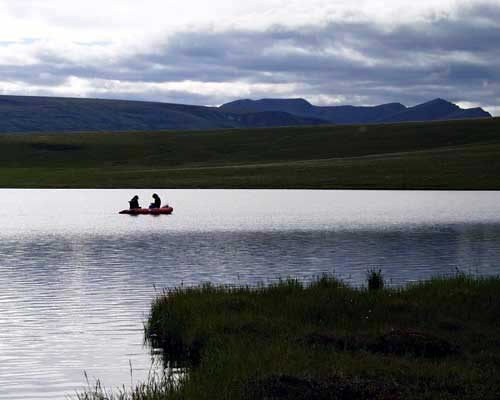 By Ned Rozell March 25, 2006
Mercury enters the atmosphere in natural ways as Earth's crust degasses, and from the burning of fossil fuels, especially coal. The toxic element often swirls in the air for about a year until it falls out with the help of rain, snow, or dust particles. Mercury can find its way to the Arctic from across the globe; a coal fire in Ireland may release mercury that ends up in Toolik Lake on Alaska's north slope.  Photo by William Fitzgerald.
On the phone from Woods Hole, Hammerschmidt explained that mercury in the atmosphere falls into lakes and rivers worldwide. That mercury then settles into lake sediments, where sulphate-reducing bacteria gobble it up and convert it to methylmercury, the form living creatures can absorb. Plankton in the lakes take up the methylmercury, larger plankton eat them, little fish eat the plankton, big fish eat the little fish, and larger animals like bears and humans eat the big fish and get dosed with methylmercury. Hammerschmidt and Fitzgerald were first interested in the lakes' levels of mercury because of the yearly return of spring sunshine to the Arctic. When the sun rises after months of darkness, it jumpstarts chemical reactions that convert mercury in the gas form to more reactive forms that accumulate in snow. "After the long period of darkness, the sun comes in and enhances the removal of mercury from the atmosphere," Hammerschmidt said. "If we've got all this mercury coming down, does that relate to more methylmercury accumulation in fish?" Hammerschmidt and Fitzgerald measured mercury levels in the body tissue of grayling and Arctic char expecting to find high levels of methylmercury. "That's not happening at all," Hammerschmidt said. Instead, northern sunlight hitting the lakes seems to be clearing them of most of the methylmercury, Hammerschmidt said. In a process called photodecomposition, sunlight strikes methylmercury and somehow shears off the methyl group, leaving behind a form of mercury that plankton and fish don't accumulate in their fat cells. "Based on the results we have right now, it's a process that's also probably happening in lakes in Minnesota, Vermont, Africa, and everywhere else," Hammerschmidt said. Scientists have studied the sun's ability to render mercury harmless in other places, but 24 hours of sunlight might intensify the effect in the Arctic. Hammerschmidt will return to Toolik Field Station for the next two summers to learn more about the process. In the recent past, he's sealed lake water in bottles and floated them on the lakes; the methylmercury within the bottles disappeared. "We know it's occurring in the lakes, but we don't know how," Hammerschmidt said. Inspired by swarms of mosquitoes at his study sites, Hammerschmidt also collected dozens of their tiny carcasses, brought them back to Massachusetts, and compared methylmercury levels within the insects to mosquitoes from Florida, Michigan, and California. He found Alaska mosquitoes had very low levels compared to the other states. Though sunlight is doing a dandy job of removing the harmful form of mercury from arctic lakes, Hammerschmidt said lakes that received more mercury input and perhaps became cloudy rather than clear (possible consequences of a warmer climate) might not be so self-cleansing. "If it gets warmer, it's possible that you'll have greater methylmercury accumulation in fish," he said.
Ned Rozell [nrozell@gi.alaska.edu]is a science writer at the institute. Publish A Letter on SitNews Read Letters/Opinions
|